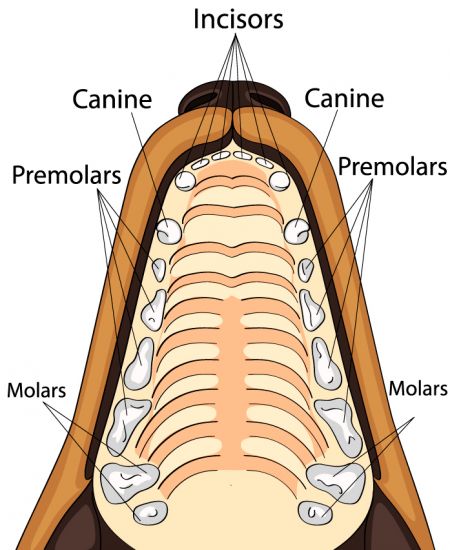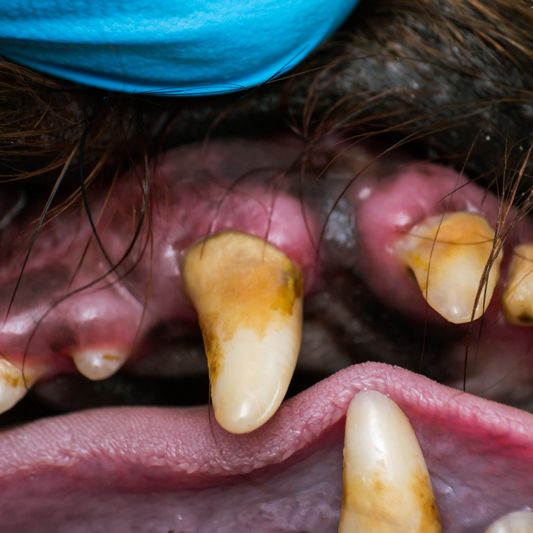Dentistry
Services Offered & Information
Dental health is a very important part of your pet's overall health. Periodontal disease can cause bad breath, tooth and gum infections, and pain. If left untreated it can affect the kidneys, liver and heart. Your pet's teeth and gums should be checked at least once per year; or sooner if you notice any of the following symptoms: bad breath, loose or broken teeth, yellow or tartar covered teeth, excessive drooling or salivating, or pain in or around the mouth. Most pets develop some dental disease by the age of three.
What is Dental Disease?
A healthy tooth has a crown covered with tough enamel, which protects the sensitive dentin underneath and extends below the gum line. When your pet eats, a film of bacteria on the tooth can grow and coat the tooth. This is called plaque, which over time hardens and becomes tartar. The tartar is irritating to the gum and provides a good environment for bacteria to grow, which causes infection and bad breath. The tartar build-up above and below the gum line causes gingivitis and periodontitis. Gum irritation is called gingivitis, and shows up red around the tooth and bleeds easily. When the gum recedes from the crown of the tooth, it exposes the underlying dentin, and the tooth becomes painful.
Cat teeth are especially prone to erosions through the enamel, which are called resorption lesions. They are not caused by a dirty mouth or bacteria, and can happen in even very young cats. Commonly the resorption starts at the gum line and progresses, eroding the sensitive dentin and causing pain.
How do we treat Dental Disease?
Dental Disease can only be treated correctly after a thorough examination of the mouth, which includes probing the teeth on both the cheek and tongue surfaces, and examining the tooth roots under the gum line with dental x-rays. We take the following steps to access your pet's teeth and gums:
- A physical exam is performed, which includes an initial oral survey on your awake pet. This allows us to arrive at a diagnosis of dental disease. Please note: We cannot perform a thorough, accurate oral assessment on an awake pet. The only way to know the extent of your pet’s oral disease is under anesthesia. We may also recommend some blood work to make sure we can provide safe anesthesia for your pet.
- When your pet is admitted to the hospital the day of the dental procedure, we will place an IV catheter and provide IV fluids and give them some pain medication before the procedure in order to calm them and make them more comfortable.
- General anesthesia is administered through a tube going down your pet’s trachea. The tube prevents fluids from the dental or stomach contents from going down into the lungs. While under anesthesia, your pet is monitored with ECG for heart rate, pulse oximetry for blood oxygen levels, temperature, respiratory rate, and blood pressure. Your pet is under constant supervision by a licensed veterinary technician or veterinary assistant while they are under anesthesia.
- A dental assessment is performed next, first by taking x-rays of all the teeth, then performing gum pocket measurements and charting of tooth condition. 80% of dental disease is not visible to the eye. This includes such problems as tooth resorption, tooth root abscesses, broken roots, unerupted teeth, and bone disease. A full oral exam looking for problems not associated with the teeth is also performed. This includes looking under the tongue (where squamous cell carcinoma likes to lurk), at the tonsils, and other soft tissue structures in the mouth.
- Now the cleaning begins. First, large chunks of tartar are gently removed; and then the tooth surface above the gum line (supragingival) is cleaned with an ultra-sonic scaler to remove visible tartar. Second, and more importantly, the tooth surface under the gum line is cleaned (subgingival). This removes the irritating tartar and bacteria from where they do the most damage. Once the tooth is cleaned, the visible surface is polished to help prevent the bacteria from being able to stick and make plaque.
- Once any diseased teeth have been identified, they need to be treated. Teeth with deep gingival pockets need to be extracted. If these teeth are left in your pet’s mouth they cause pain and spread periodontitis to other teeth. Your pet deserves a pain-free and infection-free mouth! Next the extraction site is thoroughly cleaned of infection and debris. The gum is sutured to close the area and allow healing. All pets receive a lidocaine local pain block prior to any tooth extractions.
- Home care: Once your pet’s mouth is clean, now is the ideal time to initiate some home care to keep those teeth healthy and clean and to avoid future dentals with anesthesia. Home care includes brushing, appropriate chew products or treats, and water additives, among others. Look for the VOHC seal, which indicates proof the product works. There are many YouTube videos on brushing your dogs’ and cats’ teeth. Make it FUN and ROUTINE!
Schedule your next appointment. If your pet has had extractions, there are some food and chew restrictions for two weeks. In two weeks we would like to recheck your pet’s mouth and make sure all the extraction sites are healed.
Photos
Use the left and right arrows to scroll photos.


![Schoodic Animal Hospital [logo]](/_img/ele/lgo-hz-269x120-blu.png)